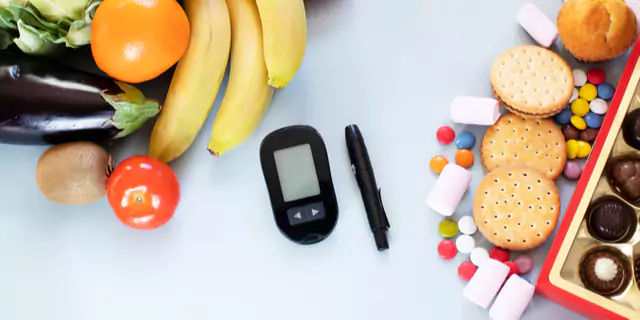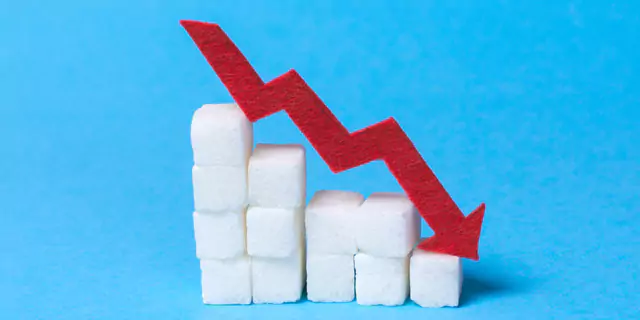Understanding Hyperglycemia vs. Hypoglycemia and How to Recognize the Differences

Key Takeways
Hyperglycemia means having high glucose, while hypoglycemia refers to low glucose. Symptoms of hyperglycemia include increased thirst and fatigue, whereas hypoglycemia can cause shakiness, sweating, and confusion. Identifying these different signs is the first step toward maintaining stable glucose levels.
Highlights:
- Prolonged hyperglycemia can lead to long-term health complications, while severe hypoglycemia can present immediate risks like confusion or loss of consciousness.
- Certain underlying conditions (like Cushing's syndrome or PCOS) and even stress can contribute to high glucose levels.
- Diet, exercise, and other lifestyle factors can influence your unique glucose responses.
- The Nutrisense program provides a biosensor and dietitian support to help you understand your patterns and make informed lifestyle choices.
The Goldilocks Balance
When monitoring your glucose, think of “Goldilocks and the Three Bears.”
Glucose levels that are too high could lead to “hyperglycemia,” and glucose levels dipping too low could lead to “hypoglycemia.”
The key to avoiding both is to find the Goldilocks balance; otherwise, it could lead to many problems. Understanding the differences between hyperglycemia and hypoglycemia, as well as how they work, should not only encourage a healthier lifestyle but also create a better mood.
Online discussions about the two sugar levels have created misconceptions and confusion about the differences and what causes them.
This topic isn’t isolated to people with diabetes. People without diabetes may experience episodes of low or high readings, and this is where non-diabetic glucose monitoring can come in handy to help you identify when these spikes and dips occur.
To understand why glucose fluctuations are important to be aware of, let's discuss what they are and the differences between the two

What is Hypoglycemia?
Hypoglycemia, or low glucose, occurs when glucose levels drop below healthy levels in the bloodstream. This can be especially troubling for those with diabetes and can prevent their bodies from getting the glucose they need.
According to the Centers for Disease Control and Prevention, glucose is necessary to supply the body’s red blood cells with energy and reduce the chances of long-term risks of experiencing severe health problems, such as heart disease, vision loss, and kidney disease.
So how do you avoid those unwanted side effects? The answer is maintaining a healthy glucose level, but that level can vary depending on your situation.
What To do For Severe Hypoglycemia
Severe hypoglycemia needs immediate action. For mild to moderate episodes, use the 15-15 rule: take 15 grams of fast-acting carbohydrate, recheck glucose about 15 minutes later, and repeat until levels recover.
For severe signs like confusion, altered mental state, seizures, loss of consciousness, or coma, use glucagon only as prescribed and per training, and call emergency services.
Plan ahead so others can help. Teach family, coworkers, or workout partners where your emergency kit is and how to use glucagon, and consider wearing a medical alert bracelet.
- Follow the 15-15 rule for mild to moderate lows, then eat a snack or meal once levels stabilize to prevent another drop.
- Use glucagon for severe lows when the person cannot safely swallow or is unconscious, then seek urgent medical care.
- Hypoglycemia unawareness means that warning symptoms can be blunted. If this has happened to you, talk with your clinician about personalized thresholds, carrying glucagon, and educating your support circle.
- If you use a continuous monitor, it measures glucose in interstitial fluid. If symptoms do not match the sensor reading, confirm with a glucometer fingerstick and treat based on symptoms. Learn how CGMs work.
Hypoglycemia Symptoms
For those with diabetes, glucose levels falling below 70 are considered low. For those without diabetes, glucose levels below 55 with hypoglycemic symptoms are considered dangerous. Symptoms to monitor for include:
- Hunger
- Irritability
- Blurred vision
- Pale skin
- Weakness
- Shakiness
- Excess sweating
- Lightheadedness/dizziness
- Anxiety
- Confusion
- Difficulty speaking
- Headaches
Causes in People Without Diabetes
People without diabetes can experience hypoglycemia in two different instances.
The first is reactive hypoglycemia, which occurs when glucose levels drop in the hours following a meal and can be an early sign of diabetes.
The second is fasting hypoglycemia. This occurs when you are refraining from eating or when you’re sleeping. Several factors can cause this, including some medications like Beta-blockers or some antibiotics, excess alcohol, hypocortisolism, hypothyroidism, pregnancy, menopause, pancreatic tumors, and anorexia.
Those who suffer from obesity, those who are prediabetic, have a family history of diabetes, or have a genetic predisposition for diabetes are at risk for non-diabetic hypoglycemia. Using a CGM without diabetes can help you determine what lifestyle habits may contribute to hypoglycemia so that you can make educated choices about your well-being.
Why Hypoglycemia Occurs in People with Diabetes
Hypoglycemia commonly occurs in people with diabetes if they take too much insulin. This is especially common in Type 1 diabetes. However, anything that reduces the body's intake of sugar can cause hypoglycemia.
According to the CDC, this includes not eating enough carbohydrates, drinking alcohol, or excessive physical activity without adjusting medications.
How Can You Prevent Hypoglycemia
There’s a lot you can do to stave off the effects of hypoglycemia.
Know Your Medication's Impact on Glucose
As mentioned previously, certain medications can reduce glucose levels. If you’re using insulin, Beta-blockers, or ACE/inhibitors, talk to your doctor about these medications.
Adjust for Exercise
Physical activity helps you stay healthy. When you move, your muscles use energy from glucose and stored glycogen. More movement usually means more energy used. Less movement means your body uses less.
If you plan to exercise more, match your fuel to the type, duration, and intensity of the workout. Eat balanced meals with protein, fiber, and unprocessed carbs. For longer or higher-intensity sessions, add a small pre- or post-workout snack. Hydrate well.
Track Glucose Routinely
Of course, none of this is effective unless you’re keeping an eye on your glucose levels. Using a CGM, you can directly see which foods have the greatest impact on you and which ones you could cut out. In recent years, continuous glucose monitoring technology has improved significantly. Plus, they’re pretty easy to use. Read more about the four best CGMs at Nutrisense.
Limit Refined Carbs
Reactive hypoglycemia can occur when people eat too much sugar or starch, such as candy, chips, or bread, and their pancreas overcompensates by pumping out too much insulin, which plummets their glucose below healthy levels and causes the symptoms of low glucose. Choosing balanced meals instead, such as those containing protein, fat, and complex carbohydrates, can help lead to an even glucose response.

What is Hyperglycemia?
Hyperglycemia, otherwise known as high glucose, occurs when too much sugar is in the bloodstream. Insulin is the body’s janitor for sweeping up and disposing of glucose from the bloodstream. Hyperglycemia can occur when insulin is insufficient or less effective at helping glucose enter cells.
When a 'Healthy' Choice Leads to an Afternoon Slump
You chose the big fruit smoothie for lunch, expecting a clean energy boost for your busy afternoon. But an hour later, you’re fighting to keep your eyes open at your desk. A wave of fatigue hits, your focus is gone, and you feel surprisingly thirsty.
You thought you made a good choice, but your body is sending a confusing signal, leaving you to wonder what’s really going on. As one member shares: “I chose Nutrisense because they were able to give me registered dietitian help to not only be able to see the data from my continuous glucose monitor, but have someone help me interpret the data.”
Hyperglycemia Symptoms
Hyperglycemia can lead to severe long-term health problems. Here are some of the most common signs and symptoms according to the CDC:
- Thirst
- Frequent urination
- Blurry vision
- Headaches and brain fog
- Increased cravings for carbs and sweets
- “Hanger”
- Poor energy levels or midday crashes
- Fatigue
- Unintentional weight loss
- Slow-healing cuts
Causes in People Without Diabetes
Just like with hypoglycemia, anybody can experience hyperglycemia, not just diabetics.
A glucose level higher than 200 mg/dl is considered too much glucose in the bloodstream. It’s not uncommon for people to experience high glucose levels at some point during the day.
A glucose spike can happen for any number of reasons, including high-intensity exercise and stress. Foods like artificial sweeteners and coffee could play a role, as well.
Causes in People With Diabetes
As mentioned before, different foods and high-intensity exercise can trigger hyperglycemia in a person with diabetes. In the case of type 1 diabetics, the body can’t increase its insulin level during a glucose spike.
How Can You Prevent Hyperglycemia
A few day-to-day habits can help you lower your risk of high glucose and keep levels steadier throughout the day.
Exercise Regularly
Maintaining a healthy amount of exercise can help keep hyperglycemia at bay. Regular exercise encourages your body to burn more energy than usual, and therefore consume more glucose.
Adopt a Glucose-Friendly Diet
Improving your diet to be more glucose-friendly can be a great way to keep your glucose balanced. One way to do that is to avoid processed foods. While food impacts will vary from person to person, research indicates that processed foods high in sugar and fat can increase glucose. Also, the frequency at which you eat could have an impact. A 2024 systematic review found that eating 2-3 meals per day promotes weight loss and glycemic control in patients with type 2 diabetes.
Maintain a Healthy Weight
Maintaining a healthy weight is crucial. One cause of hyperglycemia can also be unintentional, rapid weight loss. According to the American Diabetes Association, if you’re aiming to lose weight, be sure to establish a routine that you can stick to. That way, your body can lose weight without any unintended stress.
Be Aware of Your Medications
Be aware of what medications you’re putting in your body. Some medications can disrupt insulin’s effectiveness. Medications like steroids and beta-blockers are the usual suspects. Second-generation antipsychotics and certain antibiotics can also be high-glucose-inducing culprits.
Find the right Nutrisense programto turn insight into progress.
Frequently Asked Questions
FAQs on monitoring hyperglycemia and hypoglycemia patterns
Q1. How can Nutrisense help me spot daytime and overnight hyperglycemia and hypoglycemia patterns?
A1. A glucose biosensor tracks your glucose measured in interstitial fluid every 15 minutes, creating a continuous picture of your day and night. In the Nutrisense app, review daily graphs to compare pre- and post-meal windows, overnight trends, and recovery after activity or stress. This helps you see recurring spikes versus dips and decide what to test next with your dietitian.
Source: How it works
Q2. What should I log in the Nutrisense app to troubleshoot sudden dips or spikes?
A2. To troubleshoot sudden dips or spikes, log meals with ingredients and portions, timing, caffeine or alcohol, workouts, sleep, stress notes, and symptoms. Tag special events like travel or a new supplement. The app aligns these entries with your glucose curve so you can spot patterns and share context during nutritionist video calls.
Source: Nutrisense App
Q3. I do not have diabetes. Can Nutrisense still help me explore reactive or fasting lows?
A3. Yes. Many people without diabetes use Nutrisense to explore how meal composition and timing relate to low readings and symptoms. You will see 24/7 trends from glucose measured in interstitial fluid, run simple food experiments, and get personalized guidance from a registered dietitian to tailor meals, snacks, and activity to your needs.
Source: CGM without Diabetes
Q4. How long does each sensor last, and can I pause between sensors to focus on specific weeks?
A4. Each sensor typically lasts up to 15 days once activated. Members receive two biosensors per month and can start them on their schedule, which makes it easy to target specific weeks, like travel or a new routine. You can also pause your account in 30-day increments within plan limits if you need a break between shipments.
Source: CGM Plans
Q5. Are sensors waterproof, and how do I keep them secure during exercise or swimming?
A5. Sensors are waterproof up to 8 feet (2.4 meters) for bathing and swimming. Good skin prep and a waterproof cover can improve adhesion during workouts and hot weather. Replace a cover if edges lift, and avoid extreme temperatures such as saunas or ice baths to protect performance.
Go Beyond Glucose Data with Nutrisense
Your glucose can significantly impact how your body feels and functions. That’s why stable levels are an important factor in supporting overall wellbeing. But viewing glucose isn't enough. Nutrisense, you’ll be able to learn how to use your body's data to make informed lifestyle choices that support healthy living.
One-to-one coaching
Sign up to access insurance-covered video calls to work with a glucose expert: a personal registered dietitian or certified nutritionist who will help tailor your lifestyle and diet to your goals.
Monitor and measure what matters
With the Nutrisense CGM Program, you can monitor your glucose with health tech like glucose biosensors and continuous glucose monitor (CGM)s, and analyze the trends over time with the Nutrisense App. This will help you make the most informed choices about the foods you consume and their impact on your health.
Find your best fit
Ready to take the first step? Start with our quiz to find the right Nutrisense program to help you take control.
How Does Nutrisense Go Beyond Glucose Data
Your glucose can significantly impact how your body feels and functions. That’s why stable levels are an important factor in supporting overall wellbeing. But viewing glucose isn't enough. With Nutrisense, you’ll be able to learn how to use your body's data to make informed lifestyle choices that support healthy living.
1:1 guidance that fits your day
Sign up to access insurance-covered video calls with a glucose expert: a personal registered dietitian or certified nutritionist who will help tailor your lifestyle and diet to your goals.
Monitor and measure what matters
With the Nutrisense Program, you can monitor your glucose with health tech like glucose biosensors and continuous glucose monitors (CGM)s, and analyze the trends over time with the Nutrisense App. This will help you make the most informed choices about the foods you consume and their impact on your health.
Ready to take the first step?
Start with our quiz to find the right Nutrisense program to help you take control.

Kara Collier is a registered dietitian nutritionist and certified nutrition support clinician who is passionate about reshaping how we approach prevention, behavior change, and metabolic health. A Forbes 30 Under 30 honoree, she’s helped over 150,000 people improve their metabolic health using tools like continuous glucose monitors and behavior-focused nutrition strategies. Kara has been featured by Forbes, UC Berkeley, and HLTH, and has appeared on top podcasts like Mind Pump and The Genius Life.


.webp)

